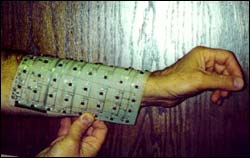High-Tech Robot Skin

High-Tech Robot Skin: Goddard technologist Vladimir Lumelsky believes the future of robotics lies with the development of a high-tech, sensor-embedded covering that would be able to sense the environment, much like human skin. Credit: Vladimir Lumelsky, NASA GSFC
Goddard Technologist Proposes Sensitive Skin Covering for Robots
A ballerina gracefully dances on a small stage. She is followed not by a male partner, but by a robotic arm manipulator that seems to sense her every move. For NASA Goddard technologist Vladimir Lumelsky, the performance shows the future of robotics.
It also demonstrates an advanced technology that Lumelsky hopes to develop as part of the push from NASA’s Goddard Space Flight Center in Greenbelt, Md. to develop niche robotics capabilities critical for carrying out the Vision for Space Exploration.
New Laboratory Under Development
Lumelsky, until recently a professor at the University of Wisconsin-Madison, has begun setting up a laboratory at Goddard to develop a high-tech covering that would enable robots to sense their environment and react to it, much like humans respond when something or someone touches their skin. Such a technology, which he refers to as a “High-Tech Skin,” is essential for carrying out the Vision for Space Exploration because the Vision depends heavily on humans and robots working together under a variety of working conditions, many of them highly unstructured, Lumelsky said.
“Robots move well on their own, especially when nothing is in the way,” Lumelsky explained. However, change the environment and a different picture emerges. “Robots should be able to react, but today’s robots can’t,” he said. “That’s the difference and that’s got to change for exploration.”
Touch Sensing Remains Key
Although great headway is being made in the area of computer vision, vision isn’t enough, he said. “Humans can survive without sight, but they can’t survive without tactile sensing. The skin is the biggest organ in our body. It’s nothing more than a huge sensor.”
Use of Infrared Sensors
The idea is to develop a “sensitive skin” that technicians could use to cover a robot. This skin will include more than 1,000 infrared sensors that would detect an object, and send the information to the robot’s “brain.” The brain would digest the information, apply reasoning and react within milliseconds by directing the robot to move. Future skin prototypes likely will have a higher density of sensors on the skin, which will provide the robots with even greater dexterity.
Challenges Ahead
The flexible plastic modules that will house the skin’s electronics will have to undergo a lot of testing to assure that they’re space qualified and able to withstand radiation and extreme changes in light and temperature, such as those that occur on other planets. In addition, embedding the electronics on a large surface material, or printing the skin like wallpaper, presents another major hurdle. Work also is needed in the area of motion-planning development and intelligence, he added.
Since moving to Goddard, Lumelsky began identifying resources needed to create his laboratory.
The sensitive skin was identified as a key technology to develop at Goddard. It would prove vital in situations where humans and robots work side-by-side in the construction of large telescopes and in the operation of both in-space and extraterrestrial equipment.
Media Contact
More Information:
http://www.gsfc.nasa.govAll latest news from the category: Power and Electrical Engineering
This topic covers issues related to energy generation, conversion, transportation and consumption and how the industry is addressing the challenge of energy efficiency in general.
innovations-report provides in-depth and informative reports and articles on subjects ranging from wind energy, fuel cell technology, solar energy, geothermal energy, petroleum, gas, nuclear engineering, alternative energy and energy efficiency to fusion, hydrogen and superconductor technologies.
Newest articles

You are What You Eat—Stanford Study Links Fiber to Anti-Cancer Gene Modulation
The Fiber Gap: A Growing Concern in American Diets Fiber is well known to be an important part of a healthy diet, yet less than 10% of Americans eat the minimum recommended…

Trust Your Gut—RNA-Protein Discovery for Better Immunity
HIRI researchers uncover control mechanisms of polysaccharide utilization in Bacteroides thetaiotaomicron. Researchers at the Helmholtz Institute for RNA-based Infection Research (HIRI) and the Julius-Maximilians-Universität (JMU) in Würzburg have identified a…

ASXL1 Mutation: The Hidden Trigger Behind Blood Cancers and Inflammation
Scientists show how a mutated gene harms red and white blood cells. LA JOLLA, CA—Scientists at La Jolla Institute for Immunology (LJI) have discovered how a mutated gene kicks off…



